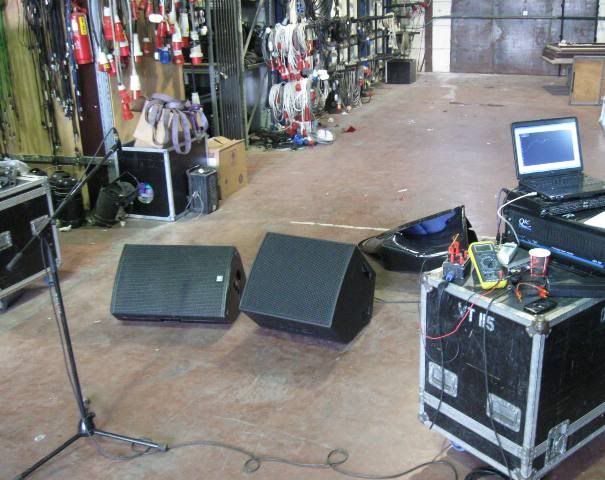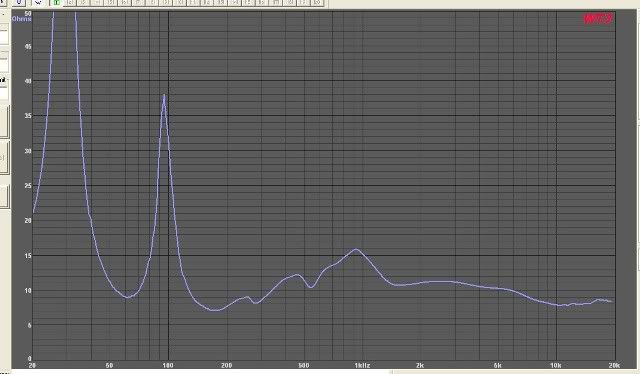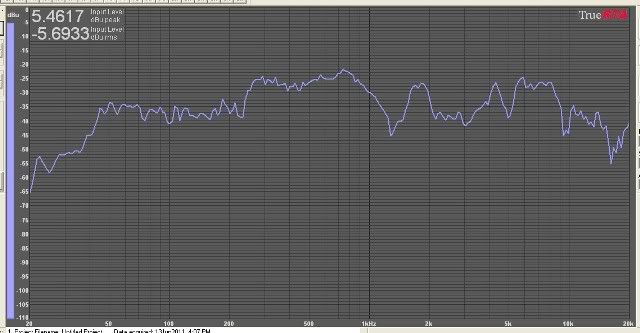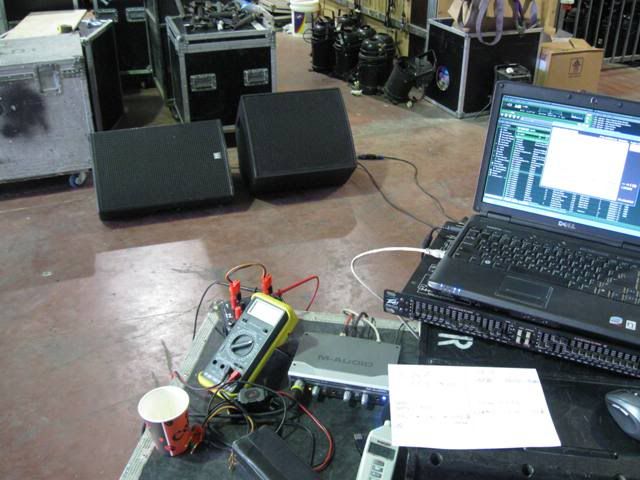The overall size of the CT115 is indeed smaller then the WH10, The CT115's profile is much lower, though it is a little longer then the WH.
The weight of the CT115 is 33Kg (by the published specs) while my WH10 weighed only 21.5Kg.
The points I was looking to compare were: efficiency, frequency response as well as overall 'tone' or musicality.
The test setup consisted of a Laptop PC, an M-Audio Solo sound interface, a DBX-M measurement mic., a QSC USA850 Amplifier and the Galaxy Audio CM140 SPL meter.
The test was performed indoors, in the middle of a big warehouse but full of equipment and stuff so no meaningful reflections or reverberations were noticed.
Both monitors were positioned on the floor in their 'natural' work position and the measurement mic. placed on the cab's output axis, one meter from the front grill
(alternately moved between the cabs). The SPL measurement was taken by placing the CM140 next to the mic's position.
Here the setup:

First: efficiency test.
Some notes:
Standard efficiency tests are taken by feeding a speaker with 1w (RMS) and measuring the produced SPL at 1 meter from the speaker.
But, as the impedance of a loudspeaker isn't constant throughout its frequency range, It may be wrong to take the speaker's published nominal impedance as true for the (1 watt) power calculations,
but rather look for the exact impedance at the frequency that the testing is actually going to be done at.
Now, despite the efforts (and some claims…) of loudspeaker manufacturers, the output response usually has some peaks and deeps.
And naturally, the maximum efficiency figure will be taken at one (the highest…) of these peaks.
So, in order to measure the cab's maximum efficiency, I needed to know its response curve - from which I will pick a peak (...) for the test frequency,
as well as its impedance curve – from which I will know the impedance at that frequency, and do the 1w calculation right.
First in line, the HK CT115:
True RTA software, fed pink noise directly from the sound card to the Amp. and on to the cab. The measurement mic. connected directly to the soundcard.
This is the response curve of the CT115:

From the plot, I chose the 150Hz peek as the frequency point for the test.
Next, the impedance test. Using the WT3 + USB dongle connected directly to the cab.
This is the impedance plot of the CT115:

From the above impedance plot, the impedance 150Hz is 7.5 ohm.
Calculating the voltage that needs to be supplied to the cab to produce 1w:
V = sqr(P*Z) = 2.73v
Now a (true rms) DVM was placed on the loudspeaker leads, 150Hz sine was generated (on True RTA) and the level was increased until 2.73v was red on the DVM.
At this point the cad was getting 1w. The Galaxy SPL meter was placed 1 meter in front of the cab, and the reading was 98dB.
A side note: The official data of the CT115 claims the efficiency of the cab to be 106 dB(1w/1m)…
Even If my measurements are off or inaccurate to some degree, I don't really know how to explain this 8dB difference.
Maybe HK took the measurement on the cab while in bi-amp mode – thus skipping any internal filter attenuation, and/or maybe just on the HF horn…
Next, the same procedure was run on the WH10.
This is the response plot of the WH10.

For the maximum efficiency test I picked the 800Hz peak/point.
And here is the impedance plot of the WH10:

From which is seen that the impedance at 800Hz is 8.5 ohm.
The calculation says 2.9v needs to be supplied to the cab to produce 1w.
So next, 800 Hz was generated and measured to be 2.9v on the cab leads.
The SPL meter at 1 meter red 104.6dB
Listening test:
The wedges were placed side by side and connected each to one side of the Amp, like so:

The CT115 channel got the signal directly from the sound card. The WH10 channel went through a 2/3 octave EQ,
with only some basic corrections applied in order to match the apparent SPL and tone to that of the CT115:
the overall gain was reduced by 5 – 6dB and some moderate attenuations were set at 600 - 800hZ and at around 6kHz,
as these peaks were really standing out.
Some musical pieces with a variety of instruments and frequencies were played, while alternating between the two cabs.
The WH10 sounded very clear and detailed. Knowing that its feed was attenuated by some 6dB (compared to the TC115)
was very reassuring as it was effortlessly comparing with the more power-hungry TC115.
I was pleasantly surprised to find the low end of the WH10 (without any EQ boost) to be much fuller
and natural/truer then that of the CT115 which sounded somewhat stressed and compressed.
(This observation also correlates to the response plots of the cabs, with the CT115 starting to roll off at about 65Hz and the WH10 at 45Hz)
On one hand, it was disappointing to hear a 'good' 15" cab missing on the low end like this,
but I guess this may be attributed to the fact that after all this is a stage monitor,
and the low end range is usually enhanced from/by the main PA.
As to dispersion, both cabs showed a very constant coverage within 30 to 45 deg. off axis. Beyond that angle,
both cabs fell drastically on the HF.
Conclusions:
I am very happy with the WH10's performance. I may try to add some notch filters to the passive x-over
to try and chop the mentioned offending peaks passively, though they are really easy to 'tame' with the send EQ.